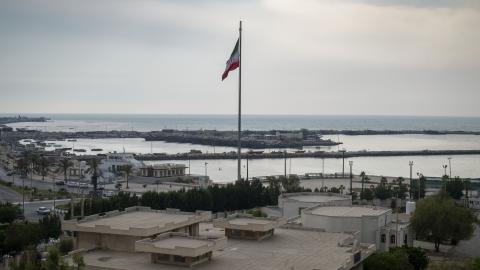Michael Singh’s piece on the evolving consensus regarding America’s Middle East policy says many important and also many true things, in particular regarding his focus on how the region is inseparable from conflicts in Europe and potential conflicts in Asia. His closing observation that “U.S. military facilities in the Gulf are closer to Taiwan than is the U.S. base at Pearl Harbor-Hickam” belongs to a family of observations no less critical for being such plain facts.
Understanding the region in the context of great power competition is a necessary analytic exercise, but it comes with built-in risks. We might identify, as Singh does, important points of consensus regarding the role the region plays with regard to China and Russia, but we should be careful not to elide significant points of disagreement regarding Middle East policy—or flirt with the notion that the region on some level does not really exist. (In the words of Singh’s piece, “...any future conflict is unlikely to respect either our bureaucratic siloes or preexisting notions of the world’s regional divisions.”) Those who live in the region certainly see themselves as locked in contests waged primarily with their neighbors, and they look to external powers asking not only what they can do for us, but also what we can do for them. Local players’ willingness to serve as instruments of the American interest trans-regionally is tied to our willingness to advance their interests at home. We de-emphasize that truism at our own peril.
It is certainly tempting to argue that the Middle East, from the American strategic perspective, does not or ought not exist. The region is the scene of a generational strategic failure of American statesmen and the American foreign policy elite of both parties. This failure will ultimately be measured against the future results of our broader ongoing contests with China and Russia, and success in those competitions may diminish its relative importance in the long run. And while there is certainly merit to arguments like those of Hal Brands, Peter Feaver, and William Inboden that, on the whole, the foreign policy establishment has done a pretty decent job since the end of the Cold War, it becomes challenging to defend such a thesis when discussing the Middle East.1 America’s harrowing experiments in democracy promotion during the Bush Administration, succeeded by the Obama Administration’s no less harrowing experiments in empowering Iran’s revolutionary regime at the expense of our traditional allies, generated ongoing crises in American politics and in the region itself that neither the Trump nor Biden Administrations have been able to resolve—and which the Biden Administration in particular has significantly aggravated.
At home, populists on both the left and the right have been substantially empowered by America’s Middle East troubles, and elements of both parties would be quite content with leaving the region all but entirely. Policy professionals might think that such a view is silly and unworkable, but it was silly and unworkable to withdraw completely from Afghanistan, too, and yet President Biden did it, with resonating effects. (NB: Bagram was even closer to Taiwan than Al Udeid.) Every time professionals are forced to contend with members of either party demanding an end to endless wars, it is because the Middle East exists, and—with respect—the professionals screwed it up.
In the region, Singh’s point that consensus holds regarding the “broad outline of an American strategy” involving a “lower level of resources,” “partner capacity,” and a military presence that is “sustainable” is true. There are no serious policy analysts arguing for the primary role of the Middle East in American foreign policy in 2024, and its tertiary status is indeed the consensus. But this statement of the consensus does elide significant points of disagreement on policy, and the elision carries real risks to our understanding of our choices. The most important disagreement regards Iran—not the Israel-Palestinian conflict, or the ambiguous simmer of Sunni extremism that always threatens to come back to a fierce boil. If the Iran issue were satisfactorily adjusted in the direction of the American interest, the question of Israel’s security would become more manageable overnight. If a network of American partners enjoyed security against state predation, the proactive suppression of militarily less serious threats like ISIS would be more easily organized— and indeed, such partners would be less vulnerable to the manipulation of powers external to the region.
Circumstances seem to have forced the Biden Administration back from the full-blown Obama Administration regional vision of an empowered Iran that would balance America’s traditional allies like Israel and the Gulf Arab states, but only so far. Singh’s formulation that Iran is a threat to be managed well-characterizes the attitude of the Biden team, which is also deeply invested in avoiding escalation with Iran to avoid being further distracted from challenges in Europe and China. This commitment to escalation avoidance has had the odd effect of making the security situation in the region look a great deal as it would if America had actually withdrawn. The volume of global shipping traffic currently rounding the Cape of Good Hope certainly gives the impression that CENTCOM and its naval component are no longer going concerns, or at least borderline impotent ones. In fact, they are still quite potent by any measure of capability.
As the current administration runs this experiment in what a post- American Middle East might look like without fully committing to the bit, it meanwhile runs the risk of allowing Iran’s nuclear capacity to fully mature. In such a Middle East, every priority of American policy in the region would instantly become more difficult to accomplish, just as Iran would find it comparatively easier to pursue its own goals—which include, not incidentally, the ejection of American military power from the region. But as Singh points out, we can’t afford to be ejected from the region because of its significance to affairs in the rest of Eurasia. In other words, our current approach—“managing these threats” with a heavy emphasis on avoidance of escalation with Iran—could well lead not to maintained or enhanced capacity to leverage the region as an asset in more important confrontations in the Pacific and Europe, but less capacity. Potentially much less.
We shouldn’t look away from the fact that the Middle East has a self-contained strategic logic of its own, and that this logic imposes real choices—and if the American consensus among professionals is indeed to manage the Iranian threat in such a way that it can eventually deploy nuclear weapons, that is in fact a choice and an important one. If we make it, however much we might rationalize it in terms of the path of least resistance typically being the easier one in the short run, we will find our material position in the greater competition for Eurasia weakened, not strengthened. And beyond material impacts, our inability to succeed with tertiary challenges—however appealing our alibi that secondary and primary challenges required our greater attention— does little to reassure anyone that, when the moment comes, we will do better at harder and more important jobs. Alternatively, we could project competence by effectively backing our Middle East partners in their competitions against their enemies, who are also our enemies, by ensuring a favorable overall balance of power in the region by means of our partnership network, and by preventing Iran from achieving nuclear status—even if it courts escalation with Iran in the shorter run.
Read in Ronald Reagan Presidential Foundation and Institute.
Enjoyed this article? Subscribe to Hudson’s newsletters to stay up to date with our latest content.



















